| Pages:
1
2
3 |
not_important
International Hazard
    
Posts: 3873
Registered: 21-7-2006
Member Is Offline
Mood: No Mood
|
|
| Quote: | Originally posted by Slimz
ill check the battery warehouse and see if they sell it, but i have heard that most of the battery stuff is industrial waste...
[Edited on 2-10-2007 by Slimz] |
Lead-acid batteries are fairly sensitive to impurities, particularly many metal ions, so the acid for them is fairly good grade but only 30 to 40
percent concentration.
Magnesium sulfate has been used as a user additive for lead acid batteries, it can squeeze a little extra life out of old batteries. There are other
after-market additives, but they generally shorten the life of a new battery and/or reduce its performance.
Some manufactures specify that they use high purity acid
http://www.hbl.in/brochures%20pdf/VRLA%20leaflet-INDIA.pdf
but if you want a really good grade then you'll buy lab grade acid, or purify a technical grade yourself.
|
|
|
AJKOER
Radically Dubious
    
Posts: 3026
Registered: 7-5-2011
Member Is Offline
Mood: No Mood
|
|
Quote: Originally posted by garage chemist  | I have run the reaction with 24g NaOH (0,6 mol) and 25g 92% TCCA (0,1 mol) in 250ml water, and 7,2g acetone (0,124 mol).
I figured that the reaction would go as follows:
6 NaOH + C3N3O3Cl3 ----> 3 NaOCl + Na3C3N3O3 + 3 H2O
Then the haloform reaction:
3 NaOCl + CH3COCH3 -----> CH3COONa + CHCl3 + 2 NaOH
|
Here are a few scenarios as to possibly why the CHCl3 production yield is low. To start, I have an issue with the 1st reaction above as there is an
implicit assumption on the stability/availability of HOCl given that the reaction actually proceeds in stages:
Initial Reaction:
NaOH + C3N3O3Cl3 ----> HOCl + NaC3N3O3Cl2
(support: see equation (1) at http://www.waterguardchem.com/tag/tcca/ which displays the reaction between TCCA and NaHCO3 forming NaC3N3O3Cl2 + CO2 + HOCl )
followed by:
NaOH + HOCl --> NaClO + H2O
but some of the hypochlorite may be moved closer to chlorate as a function of pH, temperature, concentration of HOCl and hypochlorite via the pH
dependent reaction sequence (see discussion on 'Decomposition of Solutions' at "Handbook of Detergents: Production" by Uri Zoller, Paul Sosis, page
444, link http://books.google.com/books?id=dXn3aB1DKk4C&pg=PA444&a...):
when pH over 11:
2 NaOCl --> NaClO2 + NaCl and
NaOCl + NaClO2 --> NaClO3
or, much faster for pH 5 to 9, and slower but still faster than above for pH<5:
NaClO + 2 HOCl --> NaClO3 + 2 HCl
The HOCl itself may also disproportionate or decompose:
3 HOCl --> HClO3 + 2 HCl
2 HOCl --> O2 + 2 HCl
Also, HOCl can be attacked by the newly formed HCl:
HOCl + HCl <---> Cl2 + H2O
as is the TCCA and also the NaOH, all of which can impact the haloform reaction yield.
As support, note the comment from "Process for production of an alkali metal dichloroisocyanurate and trichloroisocyanuric acid", United States Patent
4395548:
"It has unexpectly been found that the inability to form sufficient hypochlorous acid to fully chlorinate the available dichloroisocyanurate to TCCA
(a mol ratio of less than one) adversely affects each of these three factors. This low mol ratio can be caused by the decomposition of hypochlorous
acid to form hydrochloric acid according to the following reactions: 2HOCl➝2HCl+O2 3HOCl➝HCL03 +2HCl, or by a reaction consuming
hypochlorous acid, such as the formation of chloroamine: HOCl+NH3 ➝NH2 Cl+H2 O,
or by the consumption of available alkalinity as in the destruction of a triazine ring: 2C3 H3 O3 N3 +9Cl2 +18NaOH➝6CO2 +3N2 +18NaCl+12H2O"
See 3rd page, column 3, at link: http://www.google.com/patents?id=TNowAAAAEBAJ&printsec=a...
[Edited on 22-7-2012 by AJKOER]
|
|
|
AJKOER
Radically Dubious
    
Posts: 3026
Registered: 7-5-2011
Member Is Offline
Mood: No Mood
|
|
I can across a even more likely candidate as to the poor CHCl3 production yield. Per a source (see "CYANURIC AND ISOCYANURIC ACIDS", Volume 8, page
202 at http://www.scribd.com/doc/30133467/Cyanuric-and-Iso-Cyan-Uri... ) to quote:
"5.2. Oxidation.
Although the triazine ring of cyanuric acid is stable to oxidizers such as peroxydisulfate, it can be cleaved by alkaline hypochlorite: 2 H3(NCO)3 + 9
ClO- --->3 N2 + 6 CO2 + 9 Cl- + 3 H2O (24). Chloroisocyanuratesare similarly decomposed by alkaline hypochlorite (8)."
Thus, Sodium dichloroisocyanurate formed by the initial reaction:
NaOH + C3N3O3Cl3 ----> HOCl + NaC3N3O3Cl2
may prove to be detrimental to any sequence NaClO formation.
|
|
|
Bezaleel
Hazard to Others
  
Posts: 444
Registered: 28-2-2009
Member Is Offline
Mood: transitional
|
|
Copper cyanurates
Earlier in this thread, we spoke of the reactions between copper or copper ions and cyanuric acid or TCCA.
It is established in literature that copper will give a red-violet complex with sodium cyanurate, Na2[Cu(H2C3N3O3)4].6H2O. For an overview of cyanuric
acid complexes, see the excellent review article by Seifer: Russ. Journ. Coord. Chem., 2002, vol 28 iss5, pp 301-324.
Personally, I would not say the complex is red-violet, but purple:
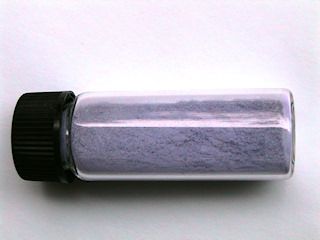
A peculiar thing happens when the substance is heated in water under stirring. The colour changes to a greyish blue, starting somewhere between 60 and
70°C. When the substance is cooled, the original purple compound is regained. The pH does not change when the colour changes, and lies constantly
around 7. (Measured values were 6.7 to 6.8.)

Does anyone have any ideas what causes the change in colour?
[Edited on 11-3-2013 by Bezaleel]
|
|
|
woelen
Super Administrator
        
Posts: 8012
Registered: 20-8-2005
Location: Netherlands
Member Is Offline
Mood: interested
|
|
It is quite special that the color returns to the original color on cooling down. It might be that there is a phase transition in the material (one
solid form to another solid form) between 53 C and 85 C. I have done similar experiments with Ag2[HgI4] and Cu2[HgI4] where the color of the
precipitate depends on the temperature and changes reversibly. A similar thing occurs with solid HgI2.
All three experiments are on the following webpage:
http://woelen.homescience.net/science/chem/exps/hgi2_thermoc...
It might be that in your case there is a similar phenomenon, albeit less spectacular.
|
|
|
AJKOER
Radically Dubious
    
Posts: 3026
Registered: 7-5-2011
Member Is Offline
Mood: No Mood
|
|
Quote: Originally posted by garage chemist  | I tested the liquid above the white stuff for chloride (added a few drops of it to some HNO3- acidified AgNO3 solution) and it was strongly positive
(thick white clouds of precipitate).
So either half of the hypochlorite disproportionated to chloride and chlorate (likely, as the solution was very hot during reaction) or half of the
chloroform was hydrolyzed by the excess NaOH.
Whatever it was, it is clear that I have to both
a) keep the solution cold during haloform reaction, and add the acetone very slowly so that this is possible, and
b) use the correct amount of NaOH: 4 mol per mol of TCCA. |
A couple of points:
1. TCCA + H2O forms, as previously noted, HOCl. In the presence of AgNO3, the reaction is given by (see http://chemistry.proteincrystallography.org/article176.html ):
3 HOCl + 3 AgNO3 = 3 HNO3 + 2 AgCl + AgClO3
I would ascribe this reaction as actually a two step reaction:
3 HOCl + 3 AgNO3 <--> 3 HNO3 + 3 AgClO
3 AgClO --warm-> 2 AgCl (s) + AgClO3 (this occurs rapidly)
-------------------------------------------------------
Net reaction, as noted above:
3 HOCl + 3 AgNO3 --> 3 HNO3 + 2 AgCl (s) + AgClO3
So my point is adding AgNO3 to a warm solution in the presence of Hypochlorous acid is not a valid test for chloride.
===========================================
2. HOCl dissolves in acetone and becomes relatively stable (limited disproportionation). This is a known procedures for extracting it from solution.
[Edited on 12-3-2013 by AJKOER]
|
|
|
Bezaleel
Hazard to Others
  
Posts: 444
Registered: 28-2-2009
Member Is Offline
Mood: transitional
|
|
Quote: Originally posted by woelen  | It is quite special that the color returns to the original color on cooling down. It might be that there is a phase transition in the material (one
solid form to another solid form) between 53 C and 85 C. I have done similar experiments with Ag2[HgI4] and Cu2[HgI4] where the color of the
precipitate depends on the temperature and changes reversibly. A similar thing occurs with solid HgI2.
All three experiments are on the following webpage:
http://woelen.homescience.net/science/chem/exps/hgi2_thermoc...
It might be that in your case there is a similar phenomenon, albeit less spectacular. |
Thanks, woelen.
Seeing the change in colour in the pictures above, it seems that merely the lines in the red part of the spectrum are disappearing on heating. This
already gives some hint about what is happening.
The blue lines are characteristic of copper in aquaous environment. The red lines might be formed by interaction with nitrogen. Comparing the deep
blue colour of copper nitrate in solution to the more sky blue colour of copper sulphate in solution, a similar process (also nitrogen involved) seems
to happen there. But I'm guessing here. When I have found more information on this, I will post it here.
My guess is that the complex bound water molecules (6 for each copper atom) do not much change their arrangement when the complex is heated, but that
the 4 cyanuric rings coordinated to the copper atom are then being rearranged in one way or another.
|
|
|
Refinery
Hazard to Others
  
Posts: 371
Registered: 17-2-2014
Member Is Offline
Mood: Still
|
|
My TCCA is mixed with sodium carbonate and I need to purify it. How it could be done safely? TCCA dissolves well in acetone and obviously there will
be no reaction on room temp since there are oxidation reactions carried out with TCCA in acetone solvent.
I could dissolve TCCA in acetone, filter and vacuum distill off the acetone, but this is quite time consuming and still involves a risk of increased
heat, because I dont have a cryogenic heat trap for sub-zero acetone.
But I need the TCCA dissolved in acetone anyway so I thought that I could measure the weight of acetone and TCCA, dissolve the mixture, filter off the
residue and measure the mass of filtrate and solution to determine the approximate amount of TCCA recovered.
|
|
|
Refinery
Hazard to Others
  
Posts: 371
Registered: 17-2-2014
Member Is Offline
Mood: Still
|
|
In this video acetone and TCCA are boiled. So when in stable or pure form they do not react with each other? So can I mix TCCA with sodium carbonate
to acetone, heat it, filter off the carbonate and distill off the acetone at water bath to make pure TCCA?
|
|
|
Metacelsus
International Hazard
    
Posts: 2539
Registered: 26-12-2012
Location: Boston, MA
Member Is Offline
Mood: Double, double, toil and trouble
|
|
Chlorinating agents such as TCCA can react with acetone to form chloroacetone. The reaction is autocatalytic due to HCl being a product, and the
reaction being more favorable in acidic conditions.
If you do anything involving acetone and TCCA, test it on a small scale first.
|
|
|
Refinery
Hazard to Others
  
Posts: 371
Registered: 17-2-2014
Member Is Offline
Mood: Still
|
|
I figured it out that since the gunk contains almost 50% of sodium carbonate, it would neutralize any acids formed in situ, and since sodium carbonate
is very slightly soluble in acetone, there will be always some. Quite the same way that adding .1% of NaOH into sodium cyanide will prevent it from
decomposing to HCN in solutions. 
I read that chloroacetone is stabilised by carbonates so it should be all way stabilising. Purity requirement is not very high - if it was, I would
buy reagent grade TCCA, as long as it is decently pure. This TCCA is from my nearest mall so I bought it, but another supplier sells much more pure
TCCA for pools which is about 90%. The rest of is an issue, though, it contains aluminium and copper sulfate, former being highly acidic and could
catalyze a reaction, therefore I think it would be necessary to employ some sodium or calcium carbonate to neutralize it.
I gotta make some tests and write the results here so it could be useful for someone else looking for ways to purify TCCA. 
My idea is to grind the tablets to fine and mix them with acetone and heat it up at water bath with reflux, and then let it cool a bit and filter
everything that left over, and then distill off the acetone to get very pure TCCA. There should not be overheating issues since water bath can never
go over 100C.  I might consider adding a little amount of sodium carbonate to the
filtered solution just in case it happens to go on it's own when distilling it. TCCA should dissolve up to 35g/100ml to acetone and maybe even more
when heated. I might consider adding a little amount of sodium carbonate to the
filtered solution just in case it happens to go on it's own when distilling it. TCCA should dissolve up to 35g/100ml to acetone and maybe even more
when heated.
Oh sorry I forgot to link the video:
https://www.youtube.com/watch?v=DDqIzxTGc78
[Edited on 20-9-2014 by Refinery]
[Edited on 20-9-2014 by Refinery]
|
|
|
AJKOER
Radically Dubious
    
Posts: 3026
Registered: 7-5-2011
Member Is Offline
Mood: No Mood
|
|
Quote: Originally posted by Polverone  | | Quote: | Originally posted by praseodymFurthermore, an interesting property of TCCA is the chemiluminescence produced during their reaction with
luminol in alkaline medium.  |
Another nice chemiluminescent reaction is the one between TCCA and hydrogen peroxide. It gives the red glow of singlet oxygen like the interaction
between metal hypochlorites and peroxide, but TCCA offers more concentrated available chlorine (and thus more visible light) than commonly available
hypochlorites.
..... |
Actually, I recently discovered the attached photo from my prior attempts on generating Singlet oxygen from dilute but cold NaOCl (8.25%) plus NaOH
with a dilute 3% H2O2 drip. I didn' t think that the camera actually caught anything, but apparently, it did barely get something.
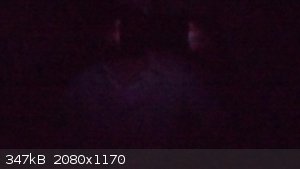
[Edited on 21-9-2014 by AJKOER]
|
|
|
j_sum1
Administrator
       
Posts: 6320
Registered: 4-10-2014
Location: At home
Member Is Offline
Mood: Most of the ducks are in a row
|
|
Reaction between TCCA and NaOH / KOH
Rather than start a new thread, I thought I would post my question here.
I have made the beautiful purple complex formed by reacting Na-DCCA with copper sufate.
(Na2[Cu(C3N3O3Cl2)4)
I was interested in analogous complexes made by substituting the Cu with Co, Ni, Pb and whatever else I had on hand. I was also interested in
substituting the Na for K or a group II metal ion.
To achieve this latter goal I attempted to make my own -DCCA compounds by reacting the appropriate hydroxide with TCCA.
I began by dissolving TCCA in NaOH solution in a 1:1 stoichiometric ratio -- hoping to achieve one dechlorination. TCCA dissolved and evolved some
gas: no strong odour. Once dissolved I attempted to react with CuSO4. No purple precipitate but instead a light blue that looked like Cu(OH)2.
I tried the same with KOH. Dissolving took a long time and there was still some TCCA sediment. Again odourless bubbles were produced. Again no
purple precipitate with copper sulfate -- just the light blue.
I concluded that I had not produced either Na-DCCA or K-DCCA, but I was unsure what reaction had occurred. My guess was that the bubbles were oxygen
and that the solutions contained some unreacted hydroxide.
After an hour or so, both mixtures showed small flecks of bright purple on top of the Cu(OH)2 precipitate. I took this as a promising sign and
possibly indicated that more time was needed to produce the -DCCA compounds. I decided to leave the NaOH/TCCA and KOH/TCCA solutions for a while and
re-test later.
I came back five days later. There was a significant pool-chlorine type smell in the air but slightly different. Both the NaOH/TCCA and the KOH/TCCA
were evolving bubbles which had a pungent odour that seemed not quite like chlorine. The sediment had fully disappeared from the KOH solution.
Adding CuSO4 gave no precipitate with either solution. This suggested that all of the hydroxide had reacted but also that there was none of the
dichloroisocyanurate compound -- evidently I had overshot the reaction and was now getting some different products.
So, my question is, what are the reaction products from a hydroxide and TCCA? (0.1 mol/L at room temp). I am confident that excess NaOH would result
in a triple dechlorination and leave cyanuric acid. I had assumed that by isng a 1:1 molar ratio the most stable product would be the dichloro
species and that whatever equilibrium existed would favour that product. I wasn't expecting the gas evolution that I got. I wasn't expecting a second
reaction destroying the Na-DCCA that I had produced.
Second question, what conditions might be required to effect a single dechlorination and maximise the -DCCA yield?
|
|
|
woelen
Super Administrator
        
Posts: 8012
Registered: 20-8-2005
Location: Netherlands
Member Is Offline
Mood: interested
|
|
TCCA and NaOH do not simply give Na-DCCA and NaCl. This is not a matter of simple exchange of OH(-) and Cl(-). TCCA is in a more oxidized state than
Na-DCCA (the difference is one equivalent of [O] between the two).
TCCA is C3N3O3Cl3.
NaDCCA is C3N3O3Cl2Na
You see the detail? In the latter, the Na has oxidation state +1, which is normal for Na. For TCCA the chlorines also have oxidation state +1, but
this is a strongly oxidizing state of chlorine. Chlorine wants to go to -1, hence a difference of +2, which is the equivalent of one [O].
If you add NaOH to TCCA, then you get Na-DCCA and NaOCl. Formally, there is exchange of Na(+) and Cl(+). This is just formally, the actual mechanism
is more complicated. The formal net reaction is
C3N3O3Cl3 + NaOH --> C3N3O3Cl2Na + HOCl
As you see, the liquid becomes acidic, by adding a base! This is a very very peculiar thing and is even more nicely demonstrated by adding ammonia to
TCCA (be careful if you do that reaction in practice, it is EXTREMELY violent). You even get Cl2 and NCl3 under such conditions, compounds which only
can be formed in acidic environments.
Hypochlorite and DCCA (or TCCA) react with each other, giving nitrogen gas and chlorinated derivatives of ammonia (chloramines). Finally, these two
chemicals destroy each other and the material loses all its oxidizing power when sufficient NaOH is added.
Just to show you the reaction, take 1 gram of calcium hypochlorite and one gram of granular Na-DCCA (or 1 gram of granular TCCA). Mix the two solids
and add one drop of water. Keep a distance from the mix, the reaction soon becomes extremely violent and the mix may even explode! DO NOT SCALE UP! Do
this reaction outside.
As all of this shows, the chemistry of TCCA and friends is remarkable and very interesting from a theoretical point of view.
|
|
|
j_sum1
Administrator
       
Posts: 6320
Registered: 4-10-2014
Location: At home
Member Is Offline
Mood: Most of the ducks are in a row
|
|
Aaah. Makes sense. I hadn't considered the oxidation state of the chlorines.
That explains everything.
I was hoping to avoid chloramines. I guess I lucked out on that one. I will read up on these before I do too much more playing. I understand that
they are a bit hazardous.
I can still play with Na-DCCA and try complexing with a few other transition metals. I recall you saying, woelen, that complexes of Pb, Co and
something else have been documented. I must look up that post and the associated paper. I have a number of transition metal compounds to experiment
with, however, most are oxides and carbonates since they come from a pottery supplier. I will need to convert to sulfates first. Time to make some
more sulfuric acid.
Incidentally, I added some Na2CO3 to neutralise the solution before disposal. I have some extremely fluffy white crystals at the bottom of the
beaker. I haven't seen any like them before.
|
|
|
Σldritch
Hazard to Others
  
Posts: 309
Registered: 22-3-2016
Member Is Offline
Mood: No Mood
|
|
The purple copper compound i suspect is actually copper (III) considering copper (III) oxide decomposes at about 75C and is coulored red. Considering
the compound of NaDCCA and Copper Sulfate is purple it might be a mixture of copper (II) and copper (III).
I also did some experimenting with it by mixing it with an arbitary amount of hydrogen peroxide wich made the suspension of the copper compound turn
white and bubble while the water turned a light blue.
The second experiment i did with it was mixing it with very concentrated sodium hydroxide wich gave very intresting results. Immidietly on addition of
the purple copper compound it turn dark brown-red and the solution soon startes to bubble of what i think is oxygen gas (since it has only a slight
smell of chlorine and metall). The solution was cold when starting the addition but increased slightly in temprature as it decomposed. I tried to
filter half of the suspesion wich seemed to go trough the filter mostly but it did not seem to increase the rate of decomposition notably. The rest of
the suspension i poured in portions into tap water wich gave an intresting effect: first it seemed to form a yellow orange solution wich within
seconds turned to green to blue to a black suspension of what looked like copper (II) oxide.
Considering the red colour, the decomposition temprature, residue and the general instability i would make relativly un-educated guess that this is
some form of copper (III); maybe percuprate seeing how it is only stable in extremely alkaline conditions.
Anyway this is my first post so please have mercy. 
EDIT: https://en.wikipedia.org/wiki/Copper(III)_oxide
[Edited on 17-4-2016 by Σldritch]
|
|
|
woelen
Super Administrator
        
Posts: 8012
Registered: 20-8-2005
Location: Netherlands
Member Is Offline
Mood: interested
|
|
I purchased some pure cyanuric acid and dissolved this in a solution of NaOH (which is not easy at all, it dissolves very slowly). With this solution,
however, I could not get the nice purple precipitate, when I add a solution of CuSO4. I only get a blue precipitate.
When I do the experiment with Na-DCCA to which some NaOH is added, then I do get the bright purple precipitate.
More investigation is necessary. Maybe lowering the pH of the solution of cyanuric acid does the trick, but my cyanuric acid only dissolves with great
difficulty if the solution is not sufficiently alkaline.
|
|
|
j_sum1
Administrator
       
Posts: 6320
Registered: 4-10-2014
Location: At home
Member Is Offline
Mood: Most of the ducks are in a row
|
|
Hmmm.
This is one of my unfinished projects. I did get the purple precipitate after adding TCCA to KOH and then using copper sulfate. To say it was
controlled would be a overstatement. I forget the exact details of my setup -- I will need to look at my notes.
One of the issues is that my TCCA is 30% borax. I don't know if it is making a difference but for this kind of experimentation I would prefer to be
playing with pure compounds.
I have not had any success with cyanuric acid (which is pure.)
| Quote: | | The purple copper compound i suspect is actually copper (III) |
No, the purple complex, (Na2[Cu(C3N3O3Cl2)4] is actually well understood and well documented. It is a well-known pool filter cloggant for people who
randomly throw chemicals into their pool.
|
|
|
Σldritch
Hazard to Others
  
Posts: 309
Registered: 22-3-2016
Member Is Offline
Mood: No Mood
|
|
Ok, i have done the experiment again and this time i had more time to be more systematic, but first this:
| Quote: | | Quote: | | The purple copper compound i suspect is actually copper (III) |
No, the purple complex, (Na2[Cu(C3N3O3Cl2)4] is actually well understood and well documented. It is a well-known pool filter cloggant for people who
randomly throw chemicals into their pool. |
I may very well be wrong but my guess is that it is in a equlibrium between copper (II) and copper (III), first because of the unusual color and then
because at the temprature of copper (III) oxide decomposition in water it turns blue wich, again i guess is due to copper (III) being less favored at
higher tempratures. So basicly the color not only comes from copper (II) (The blue part of the color) but from a small amount of copper (III) wich
gives the red color and together they make purple. I guess this is because the very oxidizing ligands copper has in this compound and that it is
possible for a unpaired electron to delocalize over a big part of the molecule from what i can see. So maybe it releases a chloride ion and
delocalizes an unpaired electron over itself. Also the result of the experiment below suggest were dealing with copper (III) even if its not a
significant part of sodium copper Dichloroisocyanate.
EDIT: Forgot to mention that you might be able to test for cuprate (III) by comparing decomposition rate when using potassium hydroxide instead of
sodium hydroxide due to the diffrent faster decompsition of potassiu cuprate (III).
Heres a helpful link: http://www.nrcresearchpress.com/doi/pdf/10.1139/v65-164
And my experiment in detail should be attatched.
[Edited on 18-4-2016 by Σldritch]
[Edited on 19-4-2016 by Σldritch]
Attachment: SodiumCopperDichloroisocyanurate+NaOH.odt (23kB)
This file has been downloaded 660 times
|
|
|
Fery
International Hazard
    
Posts: 1015
Registered: 27-8-2019
Location: Czechoslovakia
Member Is Offline
|
|
While I was servicing basic military training we had Dikacid tablets in stock. If there was a war every soldier would obtain these tablets for
dissinfection of water from unknown natural sources - to convert it to drinkable (microbiological aspect only, ineffective for neutralizing most of
chemical poisons). These tablets were white when fresh, but as you can see, now they are already quite old. Every tablet contained 14 mg of sodium
dichloroisocyanurate, now certainly less.
(picture 1, 2)
Recently I separated what to keep and what to trash and I rediscovered these tablets. So I started searching where to buy this substance now. Di-,
tri-chloroisocyanuric acid and corresponding salts of analytical grade quality are expensive (about 100 EUR per 1 kg), but swimming pool grade quite
cheap (10 EUR per 1 kg). I found these 2 in my country:
Wetter chlor start = sodium dichloroisocyanurate dihydrate 97% (small granules about 1 mm in diameter)
Blue pool mini tablets = trichloroisocyanuric acid 99% (tablets about 3 cm in diameter).
1st experiment:
(pictures 3, 4)
Dissolve 0,1 mol = 25,6 g of sodium dichloroisocynaurate dihydrate (26,4 g of Wetter chlor start) in 120 ml of water and filter into a 250 ml flask
(remove undissolved impurities). It seems to be slightly endothermic process (just touched by my hand) - if do not dissolve completely, put into 40 C
bath so it dissolves at the end.
Dissolve 0,025 mol = 6,24 g of Copper (II) sulfate pentahydrate in 30 ml of water in a beaker (if do not dissolve completely, put into 40 C warm bath)
and add to the flask while swirling its content in a hand.
Purple precipitate is formed withing few seconds which settles very slowly in few minutes (the liquid above the precipitate was pale blue).
(pictures 5, 6)
Filter out the product, wash thrice with 10 ml of water, transfer it into a dish, let it to dry out at room temperature 20 C for 2 weeks (it is sticky
and not willing to dry out fast).
CuSO4 + 4 NaC3N3O3Cl2 = Na2[Cu(C3N3O3Cl2)4] + Na2SO4
Yield of Na2[Cu(C3N3O3Cl2)4] 21,0 g.
(pictures 7, 8)
2nd experiment
(picture 9)
Dissolve 0,1 mol = 25,6 g of sodium dichloroisocynaurate dihydrate (26,4 g of Wetter chlor start) in 120 ml of water and filter into a 250 ml flask.
Dissolve 0,025 mol = 5,94 g of Nickel (II) chloride hexahydrate in 20 ml of water and add to the flask.
No precipitation occurred and reactants seemed to be vanished :-(
Dissolved 10 g of potassium chloride in 30 ml of water (endothermic, put into 40 C bath) and added to the flask while swirling its content in a hand.
A pale-green precipitate formed in the flask in few seconds :-)
(pictures 10, 11, 12, 13)
Filtered out the precipitate. Transferred the filtrate back into the flask. Washed the precipitate thrice with 10 ml of water and let it do dry out at
room temperature 20 C for 1 week.
NiCl2 + 4 NaC3N3O3Cl2 + 2 KCl + 6 H2O = K2[Ni(C3N3O3Cl2)4].6H20 + 4 NaCl
Yield of K2[Ni(C3N3O3Cl2)4].6H2O 22,0 g.
(picture 14)
The yield could be slightly improved if I knew that Na2[Ni... is soluble. The KCl could be dissolved in in the solution of sodium dichloroisocynaurate
so the final solution has 30 ml less volume.
The fun continues. Dual action, satisfaction. Dissolved 10 g of KCl in the 30 ml of washings, put the KCl solution into the flask with the filtrate
and the flask into a fridge overnight (temperature +4 C) with a hope to get more product as the solution above the precipitate seemed to be still
quite green (shifting the equilibrium to the right by increasing the concentration of K+ at the left side of the equation).
Few small crystals appeared at the bottom of the flask in the morning (approximately in a range of hundred milligrams) so I let the flask in the
fridge for 3 days occasionally swirling the flask in my hand, there were slightly more crystals at the end. The attempt to increase the yield was not
too much successful :-/ But every try counts :-)
The yield of crystals from the fridge was 1,1 g in slightly wet form. 1,0 g dry but already with signs changing color and 0,9 g after letting them in
an open dish at room temperature 20 C and average humidity. Nice bright shiny pale green crystals changed color into almost gray.
This should be investigated further... maybe a hydrate with more molecules of water is formed at 4 C which decomposes to hexahydrate at 20 C?
(rest of pictures)
According US patent 3055889 it should be possible to obtain Li2[Cu(C3N3O3Cl2)4], Ca[Cu(C3N3O3Cl2)4], Ba[Cu(C3N3O3Cl2)4], K2[Cd(C3N3O3Cl2)4] also.
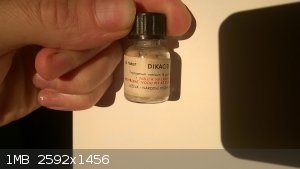 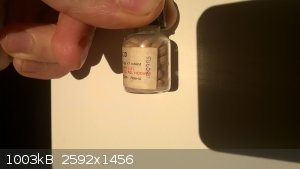
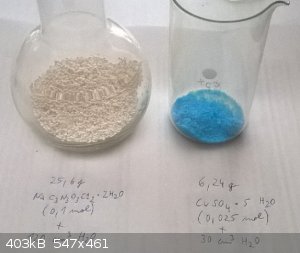 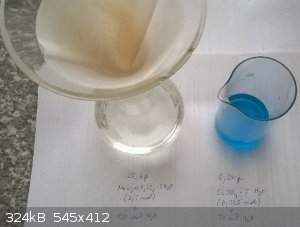
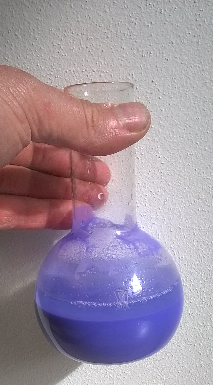 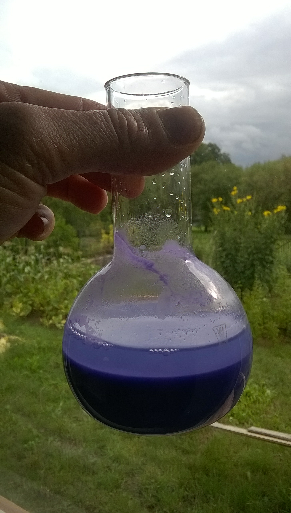
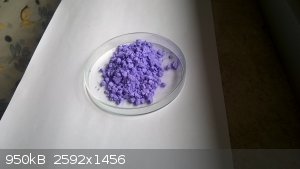 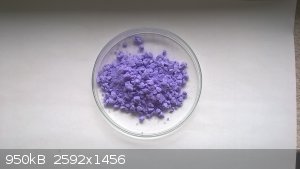
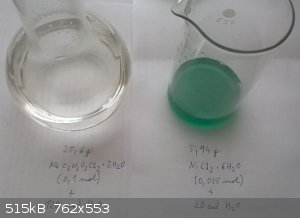
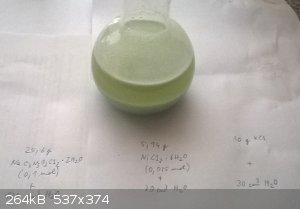 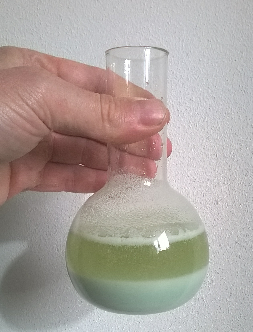 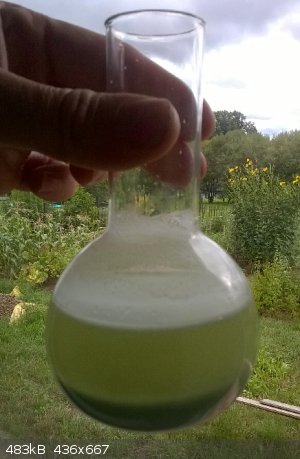 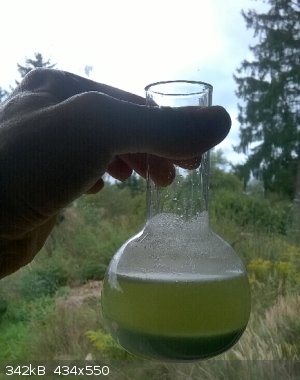
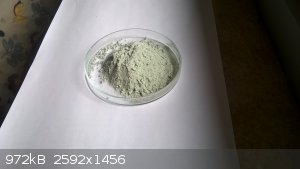
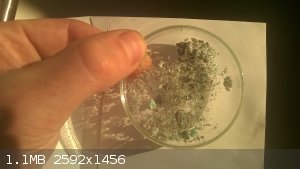 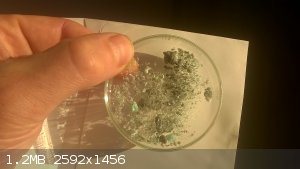
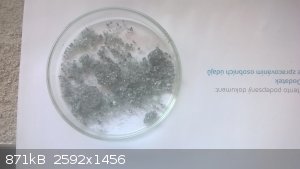 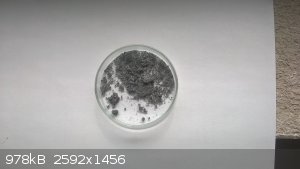 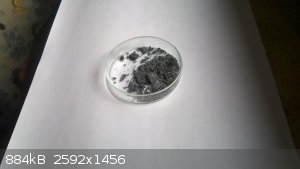
|
|
|
| Pages:
1
2
3 |